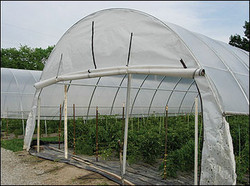 Summary
Summary
Relatively little season
extension research has
been conducted in the
southwestern United States,
particularly with low-cost
high tunnels or hoop
houses for small-scale
farmers. In this study, the
economics of winter
production of two leafy
crops [lettuce (Lactuca
sativa ) and spinach
(Spinacia oleracea)] in high
tunnels in two locations in
New Mexico were
investigated, first using a
simulation analysis in which
yields were stochastic
variables followed by a
sensitivity analysis to
examine returns from the
high tunnel designs more
closely. The returns
examined in the sensitivity
analysis were net of high
tunnel materials, crop seed
cost, and electricity. Two
planting dates were tested
and three high tunnel
designs were examined: a
single layer covering the
house (SL), a double layer
inflated with air (DL), and a
double layer inflated with
air and containing black
water barrels to store heat
(DL+B). The SL and DL
designs appear to be the
more appropriate
technology for both
locations for spinach,
whereas for lettuce the DL
+B model might be a
reasonable option in
Alcalde, a more-northern
location. Overall, the SL and
DL models provided
adequate protection for
growing crops, were less
expensive to build, provided
more interior growing
space, and resulted in
higher probabilities of
producing positive returns,
compared with the DL+B
design. The DL design
performed similarly to the
SL design, but required
running electricity to the
structure to power the
inflation fan, adding to the
cost. As a result, expected
returns in all cases were
higher using the SL design
based on the results of the
sensitivity analyses.
Combining the risk and the
sensitivity analyses
provides growers with a
unique evaluation process
to make high tunnel design,
planting date, and crop
choices.



